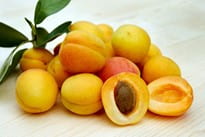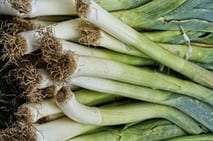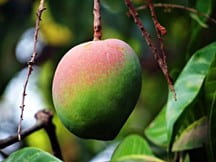The Delaware 4-H Program joins in partnership with GOLO, the pioneering wellness solutions company, to promote and provide important information on vegetables and fruits we should all eat to be healthier. We appreciate the monetary support of GOLO to our 4-H program around the initiative of Healthy Living, and their interest in the health and well-being of our 4-H youth. This is the second issue of this information we will be sharing with all our audiences.
Please take time to review this information and include more vegetables and fruits in your normal daily diets. Look for additional information we will be sharing on a quarterly basis about other vegetables and fruits to eat.
Apricots
 • Apricots are available fresh, canned, and dried
• Apricots are available fresh, canned, and dried
• Rich in vitamin E and vitamin C to protect skin cells
• Good source of potassium that improves nerve and muscle function
• Apricots have flavonoids which help to protect and strengthen your blood vessels while reducing inflammation
• Apricots contain a high-water content; one cup offers 2/3 of a cup of water
• Flavors range from sweet to sweet-tart, depending on the variety
• Originated in China, where it was first cultivated about 4,000 years ago
• Turkey and Iran are the world’s largest producer of apricots today
• There are 11 different varieties including Blenheim, Tilton, and Moorpark
https://www.webmd.com/diet/health-benefits-apricots
Asparagus
 • Asparagus is a good source of fiber, folate, and vitamin A, C, E, and K
• Asparagus is a good source of fiber, folate, and vitamin A, C, E, and K
• Rich in antioxidants that helps to reduce inflammation
• Helps give the brain a booster to prevent cognitive impairment
• Asparagus is a detoxifying compound that helps break down harmful compounds which helps fight cancer
• Available fresh, frozen, or canned
• Asparagus is a tasty, versatile vegetable that can be cooked in various ways or enjoyed raw in salads
• Contains high levels of asparagine, which serves as a natural diuretic and helps the body reduce excess salts
• There are three types of asparagus: green, white, and purple
• White asparagus are more delicate and difficult to harvest, and purple asparagus are smaller and fruitier in flavor
https://www.eatingwell.com/article/17129/5-powerful-health-benefits-of-asparagus-you-probably-didnt-know/
Banana
 • Good source of potassium that helps lower blood pressure
• Good source of potassium that helps lower blood pressure
• High in Vitamin B6 and C which may reduce the risk of cancer and diabetes
• Bananas contain several healthy antioxidants, responsible for reduced risk of heart disease
• Native to Southeast Asia and grown in many warmer areas of the world
• Many types and sizes exist, colors ranging from green to yellow and even some red
• Available fresh, frozen, and dried
• During ripening, starch is converted into sugars and reaches more than 16% of the fresh weight
• It is considered one of the most consumed fruits
• Other banana varieties include plantains and red bananas
• About 50 billion tones of Cavendish bananas are produced globally each year
• There are more than 1,000 varieties of bananas grown, but Cavendish is the most commercialized
https://www.healthline.com/nutrition/foods/bananas
Leeks
 • High in Vitamin K which help with strong bones and reduce the risk of osteoporosis
• High in Vitamin K which help with strong bones and reduce the risk of osteoporosis
• Contain carotenoids, substances that protect the eyes
• Rich in antioxidants that help reduce inflammation
• Leeks can be sliced in a salad, added to a roasted dish or soup, or used as a topping to finish a dish
• Farmers grow leeks in trenches to help keep the bulb white
• Leeks can be enjoyed cooked or raw
• The water and fiber in leeks can provide a feeling of fullness that can reduce overeating
• Like onions, leeks are root vegetables that have a mild, sweet flavor
• Greek philosopher Aristotle used a leek diet to create a clear strong voice
https://www.webmd.com/diet/health-benefits-leeks
Lemon
 • Great source of Vitamin C and B6 that help with immune function, skin health, and metabolism
• Great source of Vitamin C and B6 that help with immune function, skin health, and metabolism
• Eating lemons may lower your risk of heart disease, cancer, and kidney stones
• High in potassium which helps to lower blood pressure and maintains positive heart health
• Plant compounds in lemons may have beneficial effects on cancer, cardiovascular disease, and inflammation
• Pectin is the main fiber in lemons which helps to lower blood sugar levels
• Lemons are native to Asia. They grow on lemon trees and are a hybrid of the original citron and lime
• Due to the sour taste, lemons are typically a garnish or juiced
• The high acidity of lemons makes them good cleaning aids
• Lemon trees can produce up to 600 pounds of lemons every year
• California and Arizona produce most of the United States’ lemon crop
https://www.healthline.com/nutrition/6-lemon-health-benefits#TOC_TITLE_HDR_2
Mango
 • Rich in Vitamin C which aids the immune system, helps the body absorb iron and promotes cell growth
• Rich in Vitamin C which aids the immune system, helps the body absorb iron and promotes cell growth
• Contains Vitamin A to help maintain a healthy body
• They offer magnesium and potassium which helps maintain a healthy blood flow
• Mango has digestive enzymes, water, and dietary fiber that aid various aspects of digestive health
• Have powerful plant compounds that act as antioxidants to protect the body
• Originating in India around 5,000 years ago, mangos are one of the most widely consumed fruits in the world
• Available fresh, frozen, canned, and dried
• Mango is often referred to as the “king of fruits”
• Enjoy mango in smoothies, salsa, salads, on top of a burger or seafood dish
https://www.healthline.com/nutrition/mango#8.-May-support-eye-health
Watercress
 • Watercress are high in phytochemicals, which reduce the risk of developing certain types of cancer
• Watercress are high in phytochemicals, which reduce the risk of developing certain types of cancer
• Rich in vitamin K which is necessary for blood clotting and healthy bones
• High in antioxidants that help to lower the risk of several chronic illnesses such as diabetes, cancer, and heart disease
• High in vitamin C that boost the immune system
• Contains carotenoids lutein and zeaxanthin which are essential for eye health
• Ranked number one on the US Centers for Disease Control’s Powerhouse vegetables list
• Watercress are small, round leaves, and edible stems that have a peppery, slightly spicy flavor
• First cultivated in the UK in the early 1800s
• Watercress best eaten raw or lightly steamed and used in a wide variety of dishes
https://www.healthline.com/nutrition/watercress-benefits#TOC_TITLE_HDR_11
Pineapple
 • Pineapples are rich in vitamin C which is essential for growth and development and a healthy immune system
• Pineapples are rich in vitamin C which is essential for growth and development and a healthy immune system
• High in manganese that maintains a healthy metabolism
• Loaded with antioxidants that may reduce the risk of chronic diseases such as heart disease, diabetes, and certain cancers
• Pineapples contain digestive enzymes that break down proteins and aid in digestion
• Contain bromelain which has anti-inflammatory properties that provide pain relief for arthritis
• Eating pineapples may reduce the time it takes to recover from surgery or exercise
• Originated in South America, where early European explorers named it after its resemblance to a pinecone
• Pineapples are a sweet, convenient, and easy to incorporate into your diet
• Available fresh, canned, or frozen
• Enjoyed in smoothies, salads, or on homemade pizzas
https://www.healthline.com/nutrition/benefits-of-pineapple
Onion
 • Rich in Vitamin C and B6 that supports immune function and maintenance of skin and hair
• Rich in Vitamin C and B6 that supports immune function and maintenance of skin and hair
• High in plant compounds and antioxidants which reduce inflammation
• Onions have good source of fiber which helps the digestive tract
• Eating vegetables of the Allium genus have been linked to a lower risk of certain cancers
• Commonly used as a flavoring or side dish
• Can be baked, boiled, grilled, fried, roasted, sauteed, powdered, or eaten raw
• Vary in size, shape, and color but most common types are white, yellow, and red
• Onions can easily be added to savory dishes, including eggs, guacamole, meat dishes, soups, and baked goods
• There are less than 1,000 onion farmers in the United States
https://www.healthline.com/nutrition/onion-benefits#TOC_TITLE_HDR_11
Peas
 • Peas are rich in vitamin K, C, and A which all help to reduce the risk of diabetes
• Peas are rich in vitamin K, C, and A which all help to reduce the risk of diabetes
• High in fiber and protein which makes them so filling and slows digestion
• They have a low glycemic index which is an important factor for blood sugar control
• Peas were used in the early exploration of genetics
• Available in frozen, fresh, or canned varieties
• Since peas are high in starches, they are considered a starchy vegetable
• There are several different varieties of peas available, including yellow peas, black-eyed peas, and purple peas
• The average pea weighs between 0.1 and 0.36 grams
https://www.healthline.com/nutrition/green-peas-are-healthy#TOC_TITLE_HDR_2


